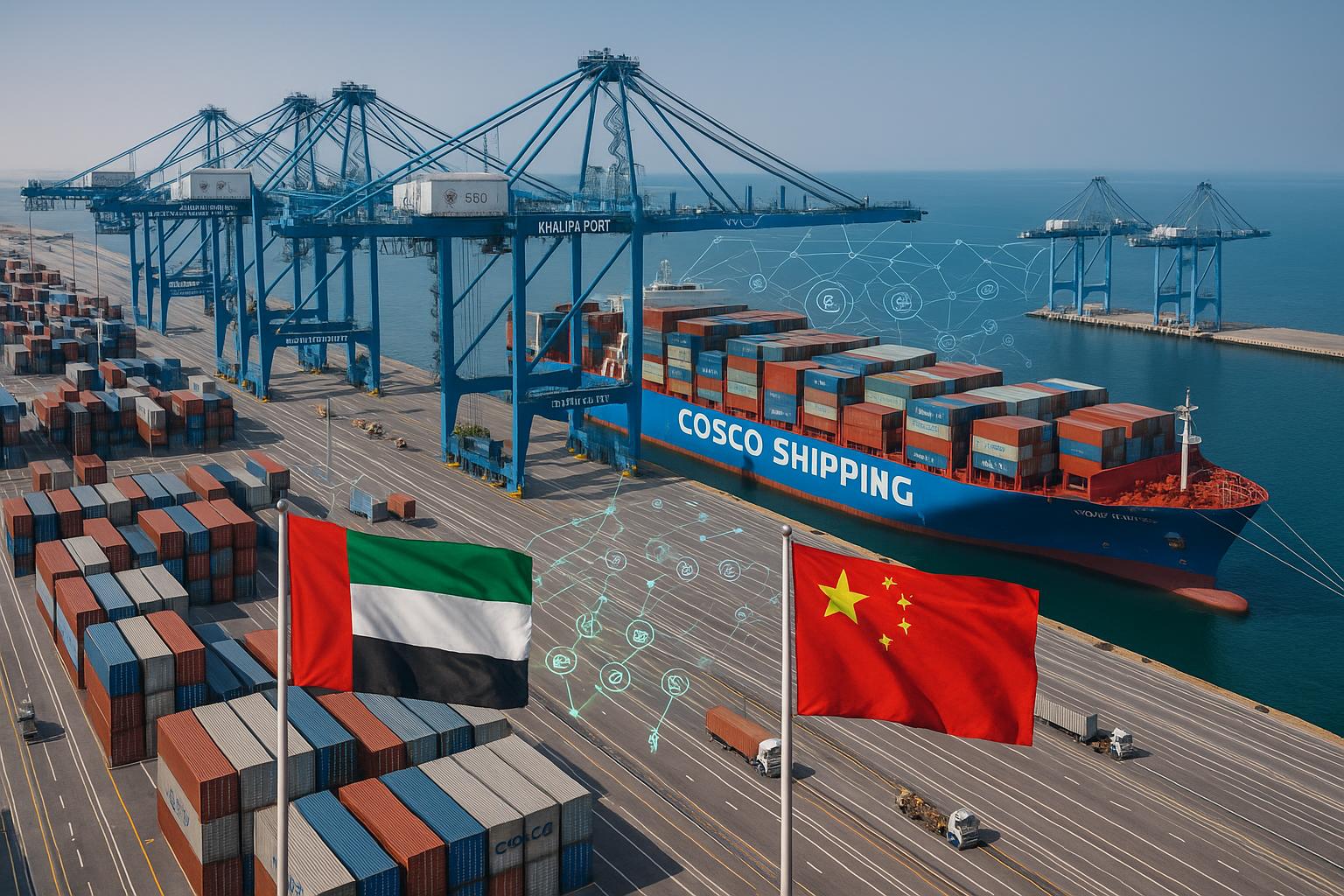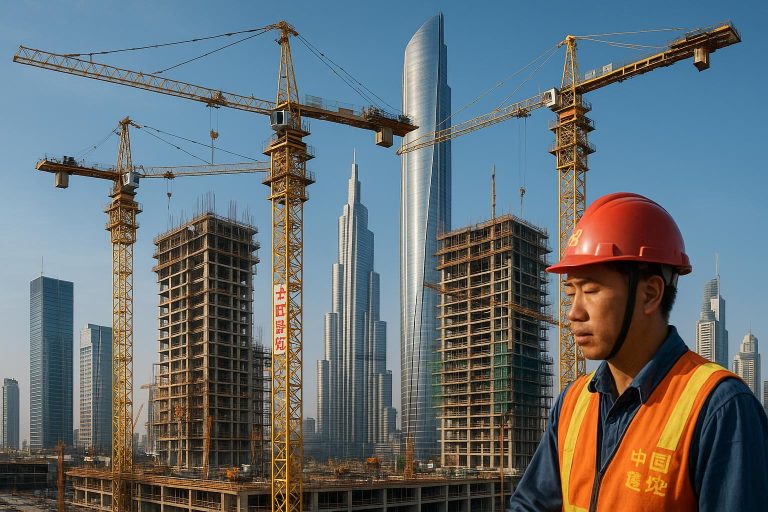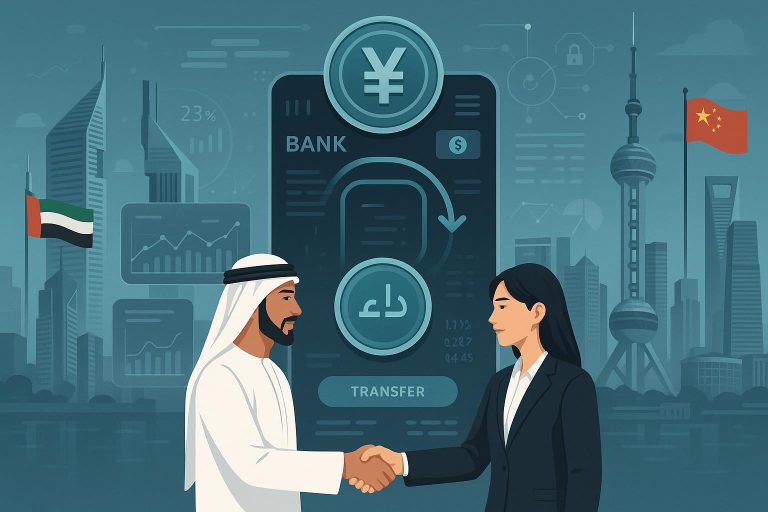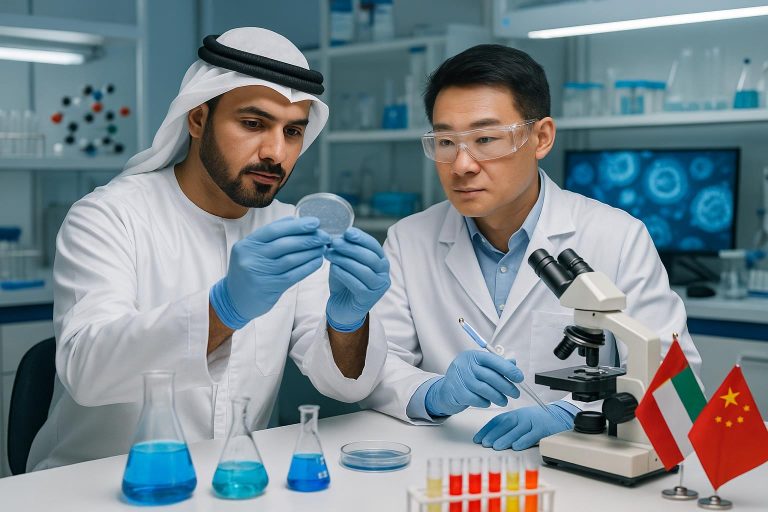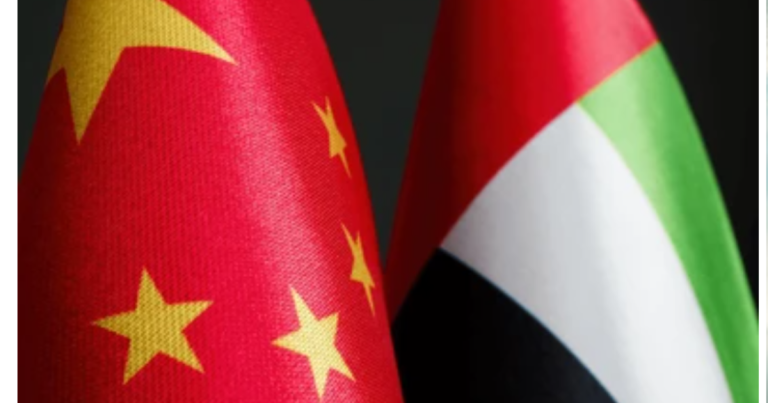Gateway to the World: The Impact of Chinese Investment in the UAE’s Ports, Logistics, and Supply Chain Infrastructure
Executive Summary
This article examines the profound impact of Chinese investment on the United Arab Emirates’ (UAE) ports, logistics, and supply chain infrastructure, positioning the UAE as a critical gateway for global trade. Driven by a comprehensive strategic partnership established in 2018, bilateral trade between the UAE and China reached a record $101.8 billion in 2024, reflecting an 800-fold growth since 1984. China remains the UAE’s largest trading partner, with over 15,000 Chinese firms operating in the Emirates. Key investments, such as the COSCO terminal at Khalifa Port and the China-UAE Industrial Capacity Zone, underscore the strategic alignment of both nations within the Belt and Road Initiative (BRI). While these collaborations foster significant economic growth and technological advancement, the article also critically assesses challenges related to geopolitical dynamics, regulatory complexities, and the need for sustainable development. Strategic recommendations include enhancing policy coordination, diversifying investment portfolios, and fostering innovation to ensure the long-term resilience and mutual benefit of this pivotal partnership.
Introduction
The United Arab Emirates (UAE) has strategically positioned itself as a global nexus for trade, logistics, and finance, leveraging its geographical advantage and forward-thinking economic policies. In recent decades, this ambition has been significantly bolstered by a burgeoning partnership with the People’s Republic of China, a global economic powerhouse. The relationship, elevated to a comprehensive strategic partnership in 2018, has seen an unprecedented surge in bilateral investment, particularly within the critical sectors of ports, logistics, and supply chain infrastructure. This analytical article delves into the multifaceted impact of Chinese investment on these foundational pillars of the UAE’s economy, exploring how such collaborations are transforming the Emirates into a pivotal ‘Gateway to the World’ for Chinese goods and capital, and a crucial hub for global commerce.
The narrative of this partnership is one of mutual benefit and strategic alignment. China, through its ambitious Belt and Road Initiative (BRI), seeks to enhance global connectivity and trade routes, finding a willing and capable partner in the UAE. The UAE, in turn, benefits from substantial capital injection, advanced technological expertise, and increased trade volumes, which further solidify its status as a regional economic leader. This article will dissect the current landscape of bilateral cooperation, identify key opportunities and strategic growth drivers, address the inherent challenges and critical considerations, and provide a case study spotlight to illustrate the practical implications of these investments. Ultimately, it aims to offer a comprehensive future outlook and strategic recommendations for sustaining and expanding this vital economic alliance, ensuring its continued positive trajectory amidst evolving global dynamics.
The Current Landscape of Bilateral Cooperation
The relationship between the UAE and China has evolved into a robust and multifaceted partnership, characterized by significant economic interdependence and strategic alignment. This collaboration is underpinned by a Comprehensive Strategic Partnership established in 2018, which has fostered an environment conducive to substantial bilateral investment and trade [1]. The quantitative indicators of this relationship are particularly striking: bilateral trade volume reached an unprecedented $101.8 billion in 2024, marking an extraordinary 800-fold increase since 1984. This growth firmly establishes China as the UAE’s largest trading partner, while the UAE stands as China’s largest export market in the Middle East and its second-largest trading partner in the broader region [1].
Chinese direct investment in the UAE has similarly surged, with over 15,000 Chinese firms now operating across various sectors within the Emirates. Concurrently, UAE investments in China demonstrated a remarkable 96% increase from the previous year, reaching $4.5 billion by the end of 2023 [1]. These figures highlight a dynamic and reciprocal investment flow that transcends traditional trade relations, signaling a deeper commitment to economic integration and shared prosperity.
At the heart of this cooperation are several key sectors, with infrastructure and logistics playing a particularly prominent role, especially in the context of China’s Belt and Road Initiative (BRI). The UAE’s strategic geographical location, coupled with its world-class infrastructure, makes it an indispensable hub for the BRI’s maritime and overland routes. A prime example of this synergy is the COSCO Shipping Ports terminal at Khalifa Port, a landmark project that significantly enhances the port’s capacity and connectivity, solidifying its role as a regional transshipment hub [1]. Furthermore, the establishment of the China-UAE Industrial Capacity Cooperation Demonstration Zone in Abu Dhabi’s Khalifa Industrial Zone (KIZAD) serves as a testament to the commitment to fostering industrial collaboration and attracting Chinese manufacturing and logistics enterprises to the UAE [1].
Beyond infrastructure, the bilateral cooperation extends to a diverse array of sectors. In energy and clean energy, there are joint investments in solar and wind power, exemplified by the Masdar-China Silk Road Fund MoU for renewable energy projects [1]. Technology and AI are also emerging as critical areas, with agreements aimed at digital transformation and leveraging AI for global influence, as seen with companies like G42 [1]. The trade and free zones sector benefits from partnerships between JAFZA and Chinese free trade zones, as well as collaborations with DP World [1]. Moreover, finance and investment are facilitated through BRI projects, with over $3.1 billion invested in the UAE, and cross-border payment cooperation between China’s CIPS and the UAE central bank [1].
Recent developments in 2024-2025 further underscore the deepening ties, with numerous MoUs signed, high-level diplomatic visits, and a growing focus on new economy sectors, entrepreneurship, tourism, and aviation. Geographically, Abu Dhabi has emerged as a primary investment hub, while Dubai continues its vital role in trade facilitation, complemented by free zone partnerships across all emirates [1]. This comprehensive engagement paints a picture of a strategic partnership that is not only economically significant but also deeply integrated across multiple dimensions, positioning the UAE as a crucial gateway for China’s global economic ambitions.
Opportunities and Strategic Growth Drivers
The strategic partnership between the UAE and China has unlocked a myriad of opportunities, particularly in bolstering the UAE’s role as a global logistics and supply chain powerhouse. Chinese investment acts as a significant catalyst, driving strategic growth across several key sectors and reinforcing the UAE’s position as a pivotal hub for international trade. The Belt and Road Initiative (BRI) serves as the overarching framework, aligning China’s global connectivity ambitions with the UAE’s vision for economic diversification and enhanced global integration [1].
One of the most prominent growth drivers is the direct investment in ports and logistics infrastructure. Projects like the COSCO Shipping Ports terminal at Khalifa Port are not merely financial transactions but strategic collaborations that bring advanced operational expertise, state-of-the-art technology, and increased cargo volumes. This investment enhances the port’s capacity, efficiency, and connectivity to global shipping routes, making it an even more attractive transshipment point for goods flowing between East and West [1]. Similarly, the China-UAE Industrial Capacity Cooperation Demonstration Zone in KIZAD is designed to attract Chinese manufacturing and logistics companies, creating industrial clusters that leverage the UAE’s logistical advantages and free zone benefits. This zone facilitates the production and distribution of goods, further integrating the UAE into global supply chains and creating new employment opportunities [1].
The expansion of Chinese e-commerce and logistics giants into the UAE further exemplifies these opportunities. JINGDONG Property’s first Middle East logistics hub in Dubai and JD.com’s implementation of smart supply chain technologies are transformative. These initiatives introduce advanced warehousing, automation, and data analytics capabilities, significantly upgrading the UAE’s logistics infrastructure and operational efficiency. The UAE is thus positioned not just as a transit point, but as a sophisticated logistics nerve center for China-Middle East trade, capable of handling complex e-commerce fulfillment and last-mile delivery challenges [1].
Beyond physical infrastructure, Chinese investment is a key enabler for the UAE’s broader economic diversification agenda. By attracting foreign direct investment (FDI) into non-oil sectors, the partnership supports the UAE’s transition towards a knowledge-based economy. This includes significant cooperation in technology and AI, with agreements focusing on digital transformation and smart city technologies. The $5 billion partnership for AI, renewable energy, and infrastructure underscores a shared commitment to innovation and future-oriented industries. Companies like G42, strategically positioned between US and China markets, are leveraging these partnerships to drive advancements in AI, contributing to the UAE’s ambition to become a global leader in emerging technologies [1].
Furthermore, the collaboration extends to vital sectors such as healthcare and pharmaceuticals, with investments like Mubadala’s acquisition of UCB Pharma’s mature business in China, and partnerships in medical technology and pharmaceutical production. In agriculture and food security, agreements on strengthening agricultural cooperation, including projects like Silal and China’s Shouguang Vegetable Group’s $33 million smart agricultural initiative, highlight efforts to enhance local food production capabilities through modern technologies like hydroponics [1]. These diverse investments not only strengthen bilateral ties but also contribute directly to the UAE’s strategic goals of economic resilience, technological advancement, and sustainable development, solidifying its role as a dynamic and indispensable global trade and innovation hub.
Challenges and Critical Considerations
While the partnership between the UAE and China presents substantial opportunities, it is imperative to acknowledge and critically assess the challenges and considerations that could impact its long-term sustainability and effectiveness. Navigating these complexities requires careful strategic planning and robust diplomatic engagement to ensure mutual benefits are maximized and potential risks are mitigated.
One significant area of concern revolves around geopolitical dynamics and regional stability. The UAE operates within a complex geopolitical landscape, and its deepening ties with China, particularly through initiatives like the BRI, can sometimes be viewed through the lens of broader international power dynamics. Balancing relationships with traditional Western allies, particularly the United States, while fostering closer economic ties with China, requires astute diplomacy. Perceptions of China’s growing influence in critical infrastructure, such as ports, can lead to scrutiny and potential geopolitical tensions, necessitating transparent communication and assurance of national sovereignty and security interests [1].
Regulatory complexities and governance standards also present a critical consideration. As Chinese investment flows into diverse sectors, ensuring alignment with the UAE’s regulatory frameworks, labor laws, environmental standards, and corporate governance practices is crucial. Differences in legal systems and business cultures can lead to operational challenges, requiring robust legal and administrative mechanisms to facilitate smooth integration and compliance. The UAE’s commitment to international best practices in governance and transparency must be upheld to maintain investor confidence and ensure equitable partnerships [1].
Furthermore, the rapid pace of development and investment necessitates a focus on sustainable development and environmental impact. Large-scale infrastructure projects, while economically beneficial, can have significant ecological footprints. Ensuring that Chinese-funded projects adhere to stringent environmental protection standards and contribute to the UAE’s sustainability goals is paramount. This includes responsible resource management, waste reduction, and the adoption of green technologies, particularly in energy-intensive logistics and industrial zones. The long-term environmental viability of these projects is essential for the UAE’s future prosperity and global reputation [1].
Another critical aspect is the potential for economic over-reliance and diversification risks. While Chinese investment significantly boosts certain sectors, an excessive concentration of foreign capital from a single source could, in the long run, create vulnerabilities. The UAE’s strategy of economic diversification aims to reduce dependence on any single sector or partner. Therefore, while welcoming Chinese investment, the UAE must continue to foster a diverse portfolio of international partnerships and investment sources to maintain economic resilience and strategic autonomy [1].
Finally, technological transfer and intellectual property rights represent an evolving challenge. As cooperation deepens in high-tech sectors like AI and digital transformation, safeguarding intellectual property and ensuring equitable technology transfer are vital. Establishing clear frameworks for collaboration that protect proprietary information and promote genuine knowledge sharing will be crucial for fostering innovation and preventing potential disputes. Addressing these challenges proactively will ensure that the UAE-China partnership continues to be a source of strength and mutual growth, rather than a point of vulnerability.
Case Study Spotlight: COSCO Shipping Ports at Khalifa Port
To illustrate the tangible impact of Chinese investment on the UAE’s logistics and supply chain infrastructure, the COSCO Shipping Ports Abu Dhabi Terminal at Khalifa Port stands as a prime example. Inaugurated in December 2018, this state-of-the-art container terminal represents a significant milestone in the bilateral cooperation between China and the UAE, directly aligning with the objectives of the Belt and Road Initiative [1].
The terminal, a joint venture between Abu Dhabi Ports and COSCO Shipping Ports Limited, boasts a quay length of 1,200 meters and an initial annual handling capacity of 2.5 million TEUs (Twenty-foot Equivalent Units). It is equipped with advanced automated and semi-automated technologies, significantly enhancing operational efficiency and turnaround times. This investment not only brings substantial capital but also introduces cutting-edge port management expertise and technology from one of the world’s largest shipping companies [1].
The strategic importance of the COSCO terminal extends beyond its operational capabilities. It solidifies Khalifa Port’s position as a regional hub for COSCO’s global network, facilitating increased trade flows between China, the UAE, and the wider Middle East, Africa, and Europe. This enhanced connectivity supports the UAE’s ambition to become a central node in global supply chains, offering a crucial gateway for Chinese goods into regional markets and beyond. The terminal also serves as a catalyst for attracting further industrial and logistics investments to the adjacent Khalifa Industrial Zone Abu Dhabi (KIZAD), creating a synergistic ecosystem that benefits from improved port access and efficiency [1]. This case study vividly demonstrates how targeted Chinese investment in critical infrastructure can yield transformative economic benefits, reinforcing the UAE’s role as a vital global trade facilitator.
Future Outlook and Strategic Recommendations
The future trajectory of the UAE-China partnership, particularly in the realm of ports, logistics, and supply chain infrastructure, appears exceptionally promising, poised for continued growth and deepening integration. The strategic alignment between China’s Belt and Road Initiative and the UAE’s vision for economic diversification and global connectivity forms a robust foundation for sustained collaboration. As both nations continue to prioritize innovation, sustainability, and digital transformation, the opportunities for mutual benefit are set to expand significantly.
Looking ahead, the UAE is expected to further solidify its role as a critical node in global supply chains, leveraging Chinese investment to enhance its logistical capabilities and expand its reach. The ongoing development of advanced logistics hubs, such as JINGDONG Property’s presence in Dubai, coupled with the adoption of smart supply chain technologies from companies like JD.com, will transform the UAE into a highly efficient and technologically sophisticated distribution center. This evolution will not only serve the burgeoning trade between China and the Middle East but also position the UAE as a preferred gateway for Chinese enterprises seeking access to broader markets in Africa and Europe [1].
To maximize the potential of this partnership and navigate future challenges, several strategic recommendations are pertinent:
- Enhance Policy Coordination and Regulatory Harmonization: Both nations should continue to strengthen existing bilateral mechanisms, such as the UAE-China Investment and Economic Cooperation Working Group, to streamline regulatory processes, harmonize standards, and ensure a predictable and transparent investment environment. This will reduce friction for businesses and encourage further cross-border investment [1].
- Diversify Investment Portfolios and Promote Joint Ventures: While infrastructure and logistics remain crucial, both countries should actively explore and promote investment in emerging sectors. This includes expanding collaborations in clean energy (e.g., solar, wind, green hydrogen), advanced technology (e.g., AI, IoT, 5G), healthcare and pharmaceuticals, and sustainable agriculture. Encouraging more joint ventures will foster knowledge transfer, local capacity building, and shared ownership in strategic projects [1].
- Foster Innovation and Digital Transformation: The UAE should continue to leverage Chinese expertise and investment in digital infrastructure and AI. Initiatives like Digital Dubai exploring smart city technologies in Shenzhen and the $5 billion AI partnership are vital. Strategic recommendations include establishing joint R&D centers, facilitating talent exchange programs, and creating innovation ecosystems that support the development and deployment of cutting-edge logistics and supply chain solutions [1].
- Prioritize Sustainability and Green Logistics: As global concerns about climate change intensify, future investments should explicitly integrate sustainability principles. This involves promoting green building standards for logistics facilities, investing in electric and autonomous transportation solutions, and developing circular economy models within industrial zones. Collaborations in renewable energy projects, such as those involving Masdar and the China Silk Road Fund, should be expanded to power the growing logistics infrastructure [1].
- Strengthen People-to-People and Cultural Exchange: Beyond economic ties, fostering deeper cultural understanding and people-to-people connections will build trust and resilience in the partnership. This includes promoting tourism, educational exchanges, and cultural events, which can indirectly support business relations by creating a more conducive environment for collaboration [1].
By proactively addressing these areas, the UAE and China can ensure their partnership continues to evolve dynamically, contributing significantly to global trade, economic stability, and sustainable development, further cementing the UAE’s role as a truly global gateway.
Conclusion
The symbiotic relationship between the UAE and China, particularly evident in the substantial Chinese investments in the UAE’s ports, logistics, and supply chain infrastructure, has unequivocally transformed the Emirates into a pivotal ‘Gateway to the World.’ This strategic partnership, formalized in 2018, has propelled bilateral trade to unprecedented levels, reaching over $101.8 billion in 2024, and has seen a significant influx of Chinese firms and capital into the UAE economy. Key projects like the COSCO Shipping Ports terminal at Khalifa Port and the China-UAE Industrial Capacity Zone exemplify the tangible benefits of this collaboration, enhancing the UAE’s connectivity, operational efficiency, and global trade footprint [1].
While the opportunities for strategic growth are immense, spanning from advanced logistics and e-commerce to clean energy, AI, and healthcare, the partnership is not without its complexities. Critical considerations such as navigating geopolitical dynamics, ensuring regulatory alignment, prioritizing sustainable development, and mitigating risks of economic over-reliance require continuous vigilance and proactive management. However, with strategic recommendations focusing on enhanced policy coordination, diversified investment, fostering innovation, and strengthening cultural ties, the future outlook remains overwhelmingly positive. The UAE-China partnership stands as a testament to the power of strategic collaboration in shaping global trade routes and fostering economic prosperity in an increasingly interconnected world.
References
[1] UAE-China Bilateral Investment Research Findings. (2025). Internal Research Document. [Placeholder URL: https://www.uaechinachamber.com/research-findings]

